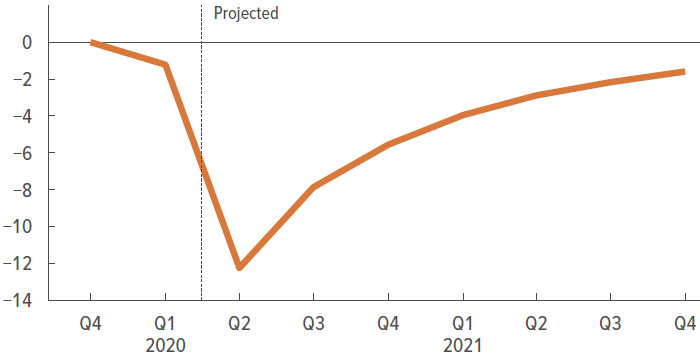Having spilled over across the world, the coronavirus pandemic has affected the US economy. So, the CBO forecasts announced in January and May differ a lot. The US Congressional Budget Office said that between 2020 and 2030, the US total nominal output would fall by $15.7 trillion (5.3%), which is less than the forecast unveiled earlier this year. The difference between those two forecast of nominal US GDP narrows from $533 billion (9.4% less than in the January forecast) towards the end of 2020 to $181 billion (by 2.2% lower) towards 2030.
The two largest differences between the two forecasts result from the economic effects of the COVID-19 pandemic in reducing output and the legislation enacted between January and early May in response, which partly offsets that reduction. Subsequently, the difference between those projections of nominal GDP narrows from $533 billion (9.4 percent lower in the May projection) by the end of 2020 to $181 billion (2.2 percent lower) by 2030. As a result of those differences, CBO projects that over the 2020–2030 period, cumulative nominal output will be $15.7 trillion less than what the agency projected in January. That difference constitutes 5.3 percent of the value for cumulative nominal GDP for that period that the agency projected in January.
Retail sales are sure to drop due to the shutdown of businesses. Investments in the country's energy sector will also decrease due to the recent collapse in oil prices. Therefore, the US Congressional Budget Office also reduced its forecast for the real GDP.
The CBO assumes that towards the end of 2020, the real US GDP will be lower by $422 billion than it was estimated in January (see the chart below). Analysts might see the green shoots of recovery only by the end of 2030. Thus, the total real US GDP over this period will be cut by $7.9 trillion.

The massive stimulus package approved by Congress will help to revive the US economy. However, experts find it hard to reckon the actual damage from the COVID-19 pandemic to the national economy in the coming years. The question is open how this will impact on the US economy. In other words, further revision of forecasts will follow.
 English
English 
 Русский
Русский Bahasa Indonesia
Bahasa Indonesia Bahasa Malay
Bahasa Malay ไทย
ไทย Español
Español Deutsch
Deutsch Български
Български Français
Français Tiếng Việt
Tiếng Việt 中文
中文 বাংলা
বাংলা हिन्दी
हिन्दी Čeština
Čeština Українська
Українська Română
Română

